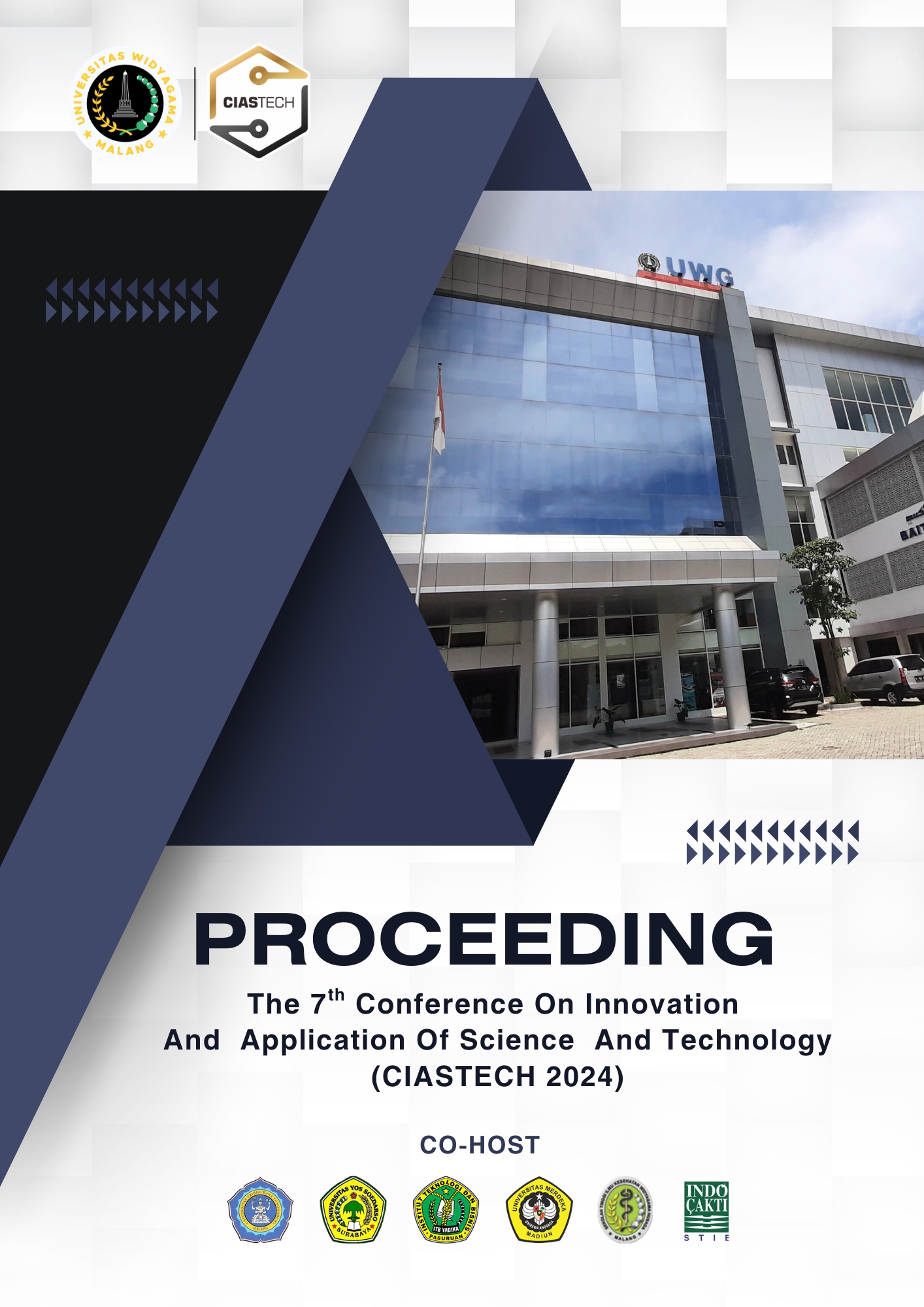METODE PELATIHAN BASIC LIFE SUPPORT PADA ANAK SEKOLAH: A SISTEMATIC LITERATURE REVIEW
DOI:
https://doi.org/10.31328/ciastech.v7i1.6907Keywords:
OHCA, BHD, BystanderAbstract
Bantuan Hidup dasar merupakan pertolongan pertama padakejadian OHCA (Out of Hospital Cardiac Arrest). Salah satu upayauntuk meningkatkan angka bystander adalah membuat orangawam mendapatkan pembelajaran bantuan hidup dasar (BHD).Mengetahui bagaimanakah metode pembelajaran yang efektif yangdigunakan pada anak sekolah merupakan tujuan dari studi literaturini. Studi dilakukan dengan metode systematic review dimanapencarian artikel menggunakan database elektronik. Pencarianmenggunakan 3 database yaitu PUBMED, COCHRANE, dan ScienceDirect. Pencarian menggunakan 5 kata kunci. Kriteria inklusi padapenelitian ini adalah artikel dipublikasikan sejak 2017-2024,menjelaskan pelatihan pada anak sekolah pada rentang usia 7-19tahun, full text, berbahasa Indonesia dan Inggris. Dari hasilpencarian menggunakan bagan PRISMA ditemukan 9 artikel yangdianalisa level evidencenya menggunakan JBI dan dilakukan analisabaik metode dan hasilnya. Dari 9 artikel yang didapatkan semuamerupakan original research. Berbagai metode terbukti berhasilmeningkatkan pengetahuan dan ketermpilan. Jenis peltihan yangmenarik dapat menjadi pilihan untuk memberikan edukasi BHD.References
[1] A. R. Panchal et al., “Part 3: Adult Basic and Advanced Life Support: 2020 American Heart Association Guidelines for Cardiopulmonary Resuscitation and Emergency Cardiovascular Care,” Circulation, vol. 142, no. 16_suppl_2, pp. S366–S468, Oct. 2020, doi: 10.1161/CIR.0000000000000916.
[2] M. E. H. Ong et al., “Outcomes for out-of-hospital cardiac arrests across 7 countries in Asia: The Pan Asian Resuscitation Outcomes Study (PAROS),” Resuscitation, vol. 96, pp. 100–108, 2015, doi: https://doi.org/10.1016/j.resuscitation.2015.07.026.
[3] K.-Y. Chen, Y.-C. Ko, M.-J. Hsieh, W.-C. Chiang, and M. H.-M. Ma, “Interventions to improve the quality of bystander cardiopulmonary resuscitation: A systematic review,” PLoS One, vol. 14, no. 2, p. e0211792, Feb. 2019, doi: 10.1371/journal.pone.0211792.
[4] F. Dobbie, A. M. MacKintosh, G. Clegg, R. Stirzaker, and L. Bauld, “Attitudes towards bystander cardiopulmonary resuscitation: Results from a cross-sectional general population survey,” PLoS One, vol. 13, no. 3, pp. e0193391–e0193391, Mar. 2018, doi: 10.1371/journal.pone.0193391.
[5] M. Valcke et al., “Awareness and willingness to perform CPR: a survey amongst Flemish schoolchildren, teachers and principals,” Acta Clin Belg, vol. 74, Jun. 2018, doi: 10.1080/17843286.2018.1482087.
[6] H. I. Kusumawati, Sutono, S. Alim, B. F. Achmad, and A. F. Putri, “Factors associated with willingness to perform basic life support in the community setting in Yogyakarta, Indonesia,” Australas Emerg Care, 2023, doi: https://doi.org/10.1016/j.auec.2023.03.003.
[7] A. Mollo, S. Beck, A. Degel, R. Greif, and J. Breckwoldt, “Kids save lives: Who should train schoolchildren in resuscitation? A systematic review,” Resusc Plus, vol. 20, p. 100755, 2024, doi: https://doi.org/10.1016/j.resplu.2024.100755.
[8] S.-H. Kim, N.-H. Park, and K.-H. Joo, “Effects of Flipped Classroom based on Smart Learning on Self-directed and Collaborative Learning,” International Journal of Control and Automation, vol. 7, pp. 69–80, Dec. 2014, doi: 10.14257/ijca.2014.7.12.07.
[9] D. C. Schroeder et al., “KIDS SAVE LIVES: basic life support education for schoolchildren: a narrative review and scientific statement from the International Liaison Committee on Resuscitation,” Circulation, vol. 147, no. 24, pp. 1854–1868, 2023.
[10] A. Cheng et al., “Part 6: resuscitation education science: 2020 American Heart Association guidelines for cardiopulmonary resuscitation and emergency cardiovascular care,” Circulation, vol. 142, no. 16_Suppl_2, pp. S551–S579, 2020.
[11] H. Li et al., “Bystander cardiopulmonary resuscitation training in primary and secondary school children in China and the impact of neighborhood socioeconomic status: A prospective controlled trial,” Medicine, vol. 97, no. 40, 2018, [Online]. Available: https://journals.lww.com/md-journal/fulltext/2018/10050/bystander_cardiopulmonary_resuscitation_training.68.aspx
[12] S. Tanaka et al., “Effect of real-time visual feedback device ‘Quality Cardiopulmonary Resuscitation (QCPR) Classroom’ with a metronome sound on layperson CPR training in Japan: A cluster randomized control trial,” BMJ Open, vol. 9, no. 6, Jun. 2019, doi: 10.1136/bmjopen-2018-026140.
[13] L. Doucet, R. Lammens, S. Hendrickx, and P. Dewolf, “App-based learning as an alternative for instructors in teaching basic life support to school children: a randomized control trial,” Acta Clin Belg, vol. 74, no. 5, pp. 317–325, Sep. 2019, doi: 10.1080/17843286.2018.1500766.
[14] A. Kovács et al., “Teaching cards as low-cost and brief materials for teaching basic life support to 6–10-year-old primary school children – a quasi-experimental combination design study,” BMC Pediatr, vol. 22, no. 1, p. 648, 2022, doi: 10.1186/s12887-022-03730-3.
[15] S. Pivač, P. Gradišek, and B. Skela-Savič, “The impact of cardiopulmonary resuscitation (CPR) training on schoolchildren and their CPR knowledge, attitudes toward CPR, and willingness to help others and to perform CPR: Mixed methods research design,” BMC Public Health, vol. 20, no. 1, Jun. 2020, doi: 10.1186/s12889-020-09072-y.
[16] H. Chamdawala, J. A. Meltzer, V. Shankar, D. Elachi, S. M. Jarzynka, and A. F. Nixon, “Cardiopulmonary resuscitation skill training and retention in teens (CPR START): A randomized control trial in high school students,” Resusc Plus, vol. 5, Mar. 2021, doi: 10.1016/j.resplu.2021.100079.
[17] M. Cons-Ferreiro, M. Mecias-Calvo, V. Romo-Perez, and R. Navarro-Patón, “Learning of Basic Life Support through the Flipped Classroom in Secondary Schoolchildren: A Quasi-Experimental Study with 12-Month Follow-Up,” Medicina (Lithuania), vol. 59, no. 9, Sep. 2023, doi: 10.3390/medicina59091526.
[18] J. Yeung et al., “The school Lifesavers study—A randomised controlled trial comparing the impact of Lifesaver only, face-to-face training only, and Lifesaver with face-to-face training on CPR knowledge, skills and attitudes in UK school children,” Resuscitation, vol. 120, pp. 138–145, Nov. 2017, doi: 10.1016/j.resuscitation.2017.08.010.
[19] A. Spartinou et al., “Effects of peer-education training on cardiopulmonary resuscitation knowledge and skill retention of secondary school students: a feasibility study,” BMJ Open, vol. 14, no. 6, p. e075961, 2024.
[20] A. Timmis et al., “European Society of Cardiology: cardiovascular disease statistics 2021,” Eur Heart J, vol. 43, no. 8, pp. 716–799, Feb. 2022, doi: 10.1093/eurheartj/ehab892.





